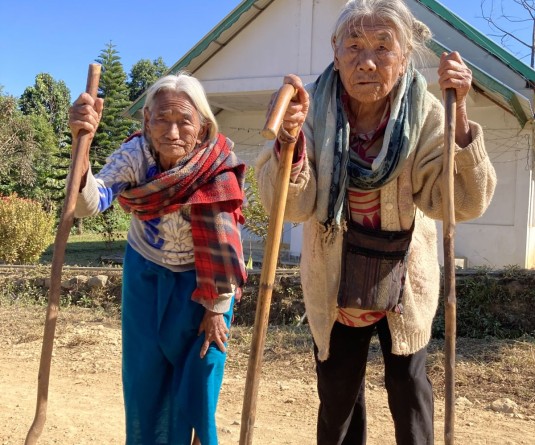
DIPR
Department of Health & Family Welfare under the directive of Government of India is all set to introduce a new vaccine, ‘Rotavirus Vaccine’ (RVV) into the Routine Immunization. It is scheduled to be launched on 2nd August 2019 across the State.
Global burden of Rotavirus diarrhea
WHO (2013) report, “Rotavirus is responsible for more than 2,15,000 deaths each year in children younger than five years of age and 3.4% of all under-five deaths worldwide”. Rotavirus is also responsible for millions of hospitalizations and clinic visits each year. It affects children around the world in both rich and poor countries. India bears the highest burden accounting for 22% of worldwide Rotavirus deaths.
Burden of Rotavirus diarrhea in India
The Indian Rotavirus Strain Surveillance Network (IRSSN) has reported that Rotavirus accounts for 40% of hospitalizations due to diarrhea in children. Rotavirus is responsible for nearly 32.7 lakh outpatient visits 8.72 lakh hospitalizations, and 78,000 deaths annually in India.
Approximately 50% of Rotavirus-associated deaths occurred in the first year of life and about 75% occur in the first two years of life. The burden of Rotavirus diarrhea and associated death varies by region, age and sex in India.
Rotavirus is estimated to cause 37% of the total diarrheal deaths a
nd 40% of the total diarrhea-related hospitalizations in children under five years of age worldwide.
So far, Rotavirus vaccine has been successfully introduced in eleven states of the country namely Himachal Pradesh, Odisha, Haryana, Andhra Pradesh, Tripura, Rajasthan, Madhya Pradesh, Assam, Tamil Nadu, Jharkhand and Uttar Pradesh, in a phase manner, from 2016.
State preparedness on RVV:
• State has completed required training at all levels- State, districts and blocks.
• Received 27000 doses of RVV from GOI -distributed to all the cold chain points as per the target
• Printed Banners, leaflets are distributed to all the districts
Important points to remember
• Rotavirus is the most common organism that causes diarrhea in children which may lead to hospitalization and death. The clinical features of Rotavirus diarrhea may vary from transient loose stools to severe diarrhea with vomiting. If not treated adequately, it may result in dehydration, electrolyte imbalance, shock and death.
• Rotavirus accounts for 40% of hospitalization due to diarrhea amongst children in India. It is responsible for nearly 32.7 lakh outpatient visits, 8.72 lakh hospitalizations and 78000 deaths annually in India of which 59,000 occur in the first two years of life
• Approximately 50% of Rotavirus-associated deaths occur in the first year of life and about 75% occur in the first two years of life
• Rotavirus transmission occurs primarily by the faeco-oral route directly from person to person, or indirectly via contaminated fomites and the virus can live for hours on hands and even longer on hard surfaces.
• Rotavirus infection and diarrhea can occur throughout the year, most commonly seen in winter season.
• Rotavirus diarrhea cannot be clinically distinguished from diarrhea due to other causes. Rotavirus diarrhea can be diagnosed in stool specimen, using laboratory tests.
• There is no specific treatment for Rotavirus diarrhea. The treatment of Rotavirus diarrhea is similar to other acute diarrheas, using ORS for correcting fluid and electrolyte imbalance and zinc for 14 days. Severe dehydration may require hospitalization for treatment with intravenous (IV) fluids.
• Rotavirus vaccine is the only specific prevention against Rotavirus diarrhea. The vaccine is effective in reducing the hospitalizations and deaths due to diarrhea in children. General measures to prevent diarrhea like good hygiene, frequent hand washing, safe water and safe food consumption, exclusive breastfeeding and vitamin A supplementation reduces the risk of Rotavirus infection, but are not enough to control the spread of the disease.
• The dose of this liquid Rotavirus vaccine currently being supplied under UIP is 5 drops (0.5 ml) given orally. Rotavirus vaccine will be administered to all infants at
At 6 weeks: OPV (2 drops oral) -Rotavirus vaccine (5 drops oral ) – fIPV (0.1ml intradermal) – PCV (0.5 ml IM)*-Pentavalent vaccine (0.5 ml IM)
At 10 weeks: OPV (2 drops oral) - Rotavirus vaccine (5 drops oral) – Pentavalent vaccine (0.5 ml IM)
At 14 weeks: OPV (2 drops oral) -Rotavirus vaccine (5 drops oral) – fIPV (0.1ml intradermal) – PCV (0.5 ml IM)*-Pentavalent vaccine (0.5 ml IM).
• The infant can be breastfed before or after vaccination.
• If the infant has minor illnesses like mild fever, upper respiratory infection etc. Rotavirus vaccine can be given. If the infant is well enough to have the other routine vaccinations, then Rotavirus vaccine can also be given. There’s no reason to postpone the vaccination unless the infant is seriously ill, having high grade fever, severe diarrhea or vomiting.
• The upper age limit for giving the first dose of Rotavirus vaccine is one year of age. If the child has received first dose of Rotavirus vaccine by one year of age, subsequent 2nd and 3rd dose of the vaccine should be given at an interval of 4 weeks between two doses to complete the course.
• Rotavirus vaccine will be provided free of cost through routine immunization sessions under UIP. It will be provided at all government health facilities including hospitals, medical colleges, urban dispensaries, PHCs, CHCs, sub centers and outreach session sites.
• Rotavirus vaccine is a safe vaccine. However, mild and transient symptoms including vomiting, diarrhea, cough, runny nose, fever, irritability and rash may be associated with Rotavirus vaccination.A rare adverse event known as intussusception (one part of bowel folding/telescoping into another) has been reported after Rotavirus vaccine. As per the WHO position paper (2013), “in some but not all settings, post-marketing surveillance of both currently available Rotavirus vaccines has detected a small increased risk of intussusception (about 1–2/100 000 infants vaccinated) shortly after the first dose”. In such cases parents are requested to inform the nearest Health centre as it is easily treatable.




